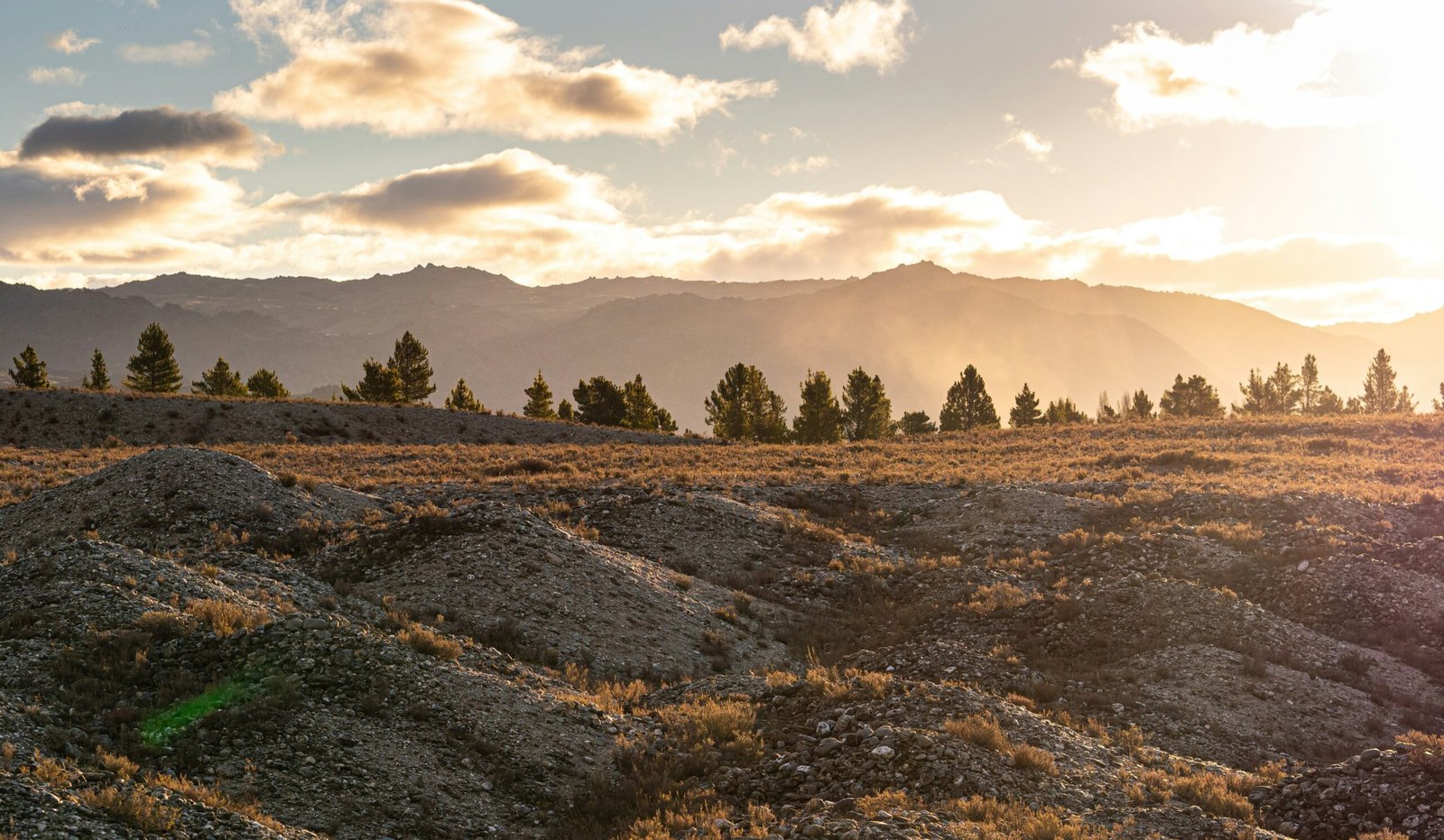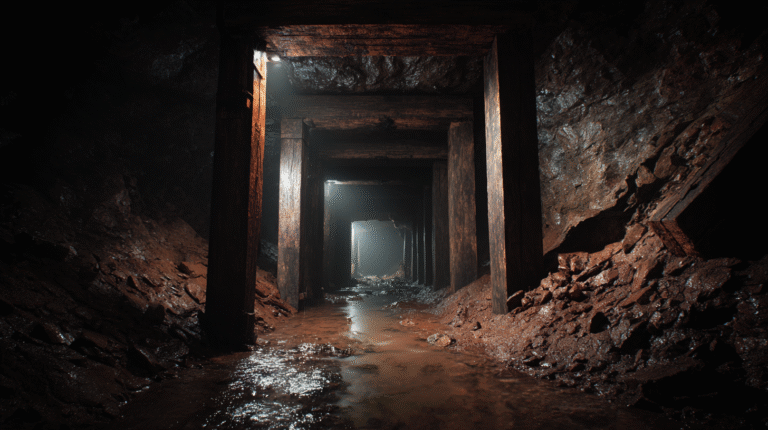Welcome to our latest article, where we explore the fascinating world of gold mining and its potential contribution to conservation efforts.
First Posted December 20, 2024 | Last Updated on August 21, 2025 by Ryan ConlonDisclosure: This Post Contains Affiliate Links; We earn a commission on purchases.
By adopting sustainable methods, the gold mining industry can play a crucial role in protecting our planet’s precious resources.
From employing advanced technology to adhering to strict legislation, the industry is evolving to ensure environmental quality and biodiversity conservation.
Gold mining involves the extraction of tiny flakes of gold from igneous rocks and alluvial deposits in rivers and streams.
While early prospectors relied on simple techniques like panning and rocking boxes, modern prospectors now utilize cutting-edge machinery and innovative methods.
Stay tuned as we delve into the process of gold mining, examine its environmental impacts, and explore the challenges and opportunities associated with abandoned mines.
Along the way, we’ll highlight the importance of adopting sustainable practices and the benefits of voluntary mine cleanups.
But first, let’s take a moment to appreciate the beauty and allure of gold mining with this stunning image:
Now that we have your attention, let’s look at the intricacies of gold mining and how it can contribute to the protection of our environment and the preservation of precious resources.
The Process of Gold Mining
Gold mining is a fascinating and intricate process that involves extracting this precious metal from various sources. Let’s delve deeper into the process of gold mining, exploring the methods used by early prospectors and the modern techniques employed today.
Early Prospecting Methods
In the early days of gold mining, prospectors relied on simple yet effective methods to extract gold from alluvial deposits. Alluvial deposits refer to gold that is deposited in rivers and streams, often found in the form of tiny flakes within igneous rocks.
“Panning and rocking boxes were commonly used by early prospectors to separate gold from alluvial deposits,” explains Dr. Sarah Johnson, a renowned geologist specializing in mineral extraction techniques.
Panning involved swirling a mixture of water and sediment in a pan, allowing the denser gold flakes to settle at the bottom. Rocking boxes, on the other hand, used a rocking motion to separate gold from the lighter sediment.
Modern Prospecting Techniques
In the modern era, gold prospectors have access to advanced technology and machinery, enabling them to extract gold from a variety of sources. Geological maps and satellite information help identify potential gold-bearing areas.
Modern prospecting techniques involve a combination of geological analysis, satellite data, and heavy machinery,” states Dr. Johnson. “These methods allow prospectors to target deeper water or large-scale open pit mines.”
One modern technique called hydraulic mining involves using high-pressure water jets to dislodge gold-bearing sediment from hillsides. While this method is not considered environmentally sensitive, it is still utilized in some cases.
The Extraction Process
Once gold-bearing rocks or sediment have been unearthed, the process of gold extraction begins. This involves several stages, including crushing the rock, dissolving the gold, and refining it into pure material.
- The rock is first crushed into smaller pieces using heavy machinery, such as crushers or stamp mills.
- To separate the gold from the crushed rock, a process called cyanidation is used. Cyanide is mixed with water and sprayed onto the crushed material to dissolve the gold particles.
- The dissolved gold is then recovered from the cyanide solution through a process called carbon adsorption. Activated carbon absorbs the gold, forming a solid compound.
- Finally, the gold is refined to remove any impurities, resulting in pure gold that can be used for various purposes.
The Fascinating World of Gold Mining
Gold mining is a dynamic and ever-evolving industry that has undergone significant transformations over the years. From the early prospecting methods of panning and rocking boxes to the modern techniques that involve advanced technology, the process of gold mining continues to captivate researchers, geologists, and miners alike.
| Early Prospecting Methods | Modern Prospecting Techniques | The Extraction Process |
|---|---|---|
| Panning | Geological analysis | Crushing the rock |
| Rocking boxes | Satellite data | Dissolving the gold with cyanide |
| Heavy machinery | Refining the gold into pure material |
Environmental Impacts of Gold Mining
Gold mining can have significant environmental consequences, including risks associated with cyanide usage, water pollution, and land damage. Let’s explore these impacts in more detail.
1. Cyanide and Environmental Risk
The use of cyanide in gold mining poses a considerable environmental risk. Cyanide, a highly toxic substance, can leach into the soil and groundwater, contaminating local ecosystems. Past incidents of cyanide spillages have resulted in severe damage to water sources and aquatic life.
“The International Cyanide Management Code provides guidelines for safe cyanide usage in gold mining, aiming to minimize environmental impacts and protect surrounding ecosystems.”
2. Water Pollution
Gold mining operations, especially hydraulic mining techniques, can lead to water pollution. By disturbing riverbeds and altering the natural flow of water bodies, gold mining can release sediment and harmful chemicals into nearby rivers and streams. This contamination endangers aquatic species and compromises water quality.
3. Land Damage
Gold mining activities, particularly hydraulic mining, can cause extensive land damage. Excavation and earthmoving disrupt the natural landscape, leading to erosion, deforestation, and habitat destruction. Moreover, the construction of mines and infrastructure can permanently alter ecosystems and result in the loss of biodiversity.
To address these environmental impacts, various measures have been implemented to protect the environment and promote responsible mining practices.
“The Initiative for Responsible Mining Assurance (IRMA) and other similar programs promote responsible mining practices and work towards minimizing the environmental impacts associated with gold mining.”
By adopting sustainable mining methods and adhering to strict regulations and guidelines, the gold mining industry aims to mitigate the environmental risks and ensure the long-term preservation of natural ecosystems.
| Environmental Impacts | Consequences |
|---|---|
| Cyanide Usage | Leaching into soil and groundwater, endangering ecosystems and human health. |
| Water Pollution | Contaminated water sources, compromised water quality, and harm to aquatic life. |
| Land Damage | Erosion, deforestation, habitat destruction, and loss of biodiversity. |
Abandoned Mines and Environmental Challenges
The United States has a significant number of abandoned mines, which have resulted in severe environmental impacts, including water pollution in many headwater streams. These abandoned mines pose a threat to aquatic ecosystems and public health. Cleaning up these sites is a crucial task, but it comes with various challenges.
One major challenge is the substantial funding required for mine cleanup. The cost of assessing and remedying the environmental damage caused by abandoned mines can be significant, making it difficult to allocate the necessary resources. Additionally, liability issues complicate the cleanup process.
Under current federal regulations, parties involved in mine cleanup can be held liable for the environmental impacts of the abandoned mine sites. This liability presents a legal risk, as parties assisting in cleanup efforts may face legal consequences if their actions fail to completely eliminate pollution or if accidents occur during the cleanup process.
However, addressing these challenges is essential to safeguard the environment and public health. To encourage more stakeholders to undertake voluntary mine cleanups, it is crucial to remove regulatory disincentives and replace them with positive incentives. Adopting a proactive approach that incentivizes responsible mine cleanup can help mitigate the environmental consequences of abandoned mines.
The cleanup of abandoned mines is not only a responsibility but also an opportunity to restore the ecological balance and ensure the well-being of communities affected by these sites. By addressing the environmental challenges associated with abandoned mines, we can make significant progress in protecting water quality and preserving precious ecosystems.
Liability Issues and the Need for Collaboration
The liability issues surrounding abandoned mines necessitate collaboration among different stakeholders, including governmental agencies, private organizations, and local communities. By working together, these parties can pool their resources, expertise, and knowledge to develop effective strategies for mine cleanup.
Collaborative efforts can also help distribute the financial burden associated with mine cleanup. By sharing costs and resources, multiple stakeholders can contribute to the cleanup process without being overwhelmed by the financial implications.
Innovative Approaches to Mine Cleanup
In addition to collaborative efforts, innovative approaches can play a significant role in addressing the challenges of abandoned mine cleanup. Embracing new technologies and techniques can streamline the cleanup process and make it more efficient.
Furthermore, exploring market-based solutions and creating economic opportunities related to mine cleanup can incentivize stakeholders to invest in these efforts. By integrating economic benefits with environmental objectives, innovative approaches can create a win-win situation, promoting mine cleanup while revitalizing local economies.
Incentives for Mine Cleanup
Besides removing regulatory disincentives, it is important to create an incentive framework that rewards mine cleanup efforts. Cleaning up abandoned mines provides economic benefits to various stakeholders and encourages voluntary participation in mine cleanup initiatives.
Economic Benefits for Stakeholders
Cleaning up abandoned mines offers economic advantages to different entities involved:
- The federal government: By cleaning up abandoned mines, the federal government can enhance environmental protection, improve land value, and promote sustainable development.
- Downstream states and localities: Removing pollutants from abandoned mines can enhance water quality, safeguard public health, and support recreational activities such as fishing and boating.
- Property owners: Cleanup efforts can increase property values and minimize potential liability risks associated with contaminated sites.
- Recreationists: Cleaning up abandoned mines can provide a safer and healthier environment for outdoor enthusiasts who enjoy hiking, camping, and exploring natural areas.
- Conservationists: Mine cleanup contributes to conserving natural ecosystems, protecting wildlife habitats, and preserving biodiversity.
Positive Incentives for Voluntary Cleanups
Positive incentives play a crucial role in encouraging stakeholders to participate voluntarily in mine cleanup efforts. Such incentives can include:
- Financial rewards: Offering financial incentives to individuals or organizations for successfully completing mine cleanup projects can motivate participation and ensure the availability of necessary resources.
- Tax benefits: Providing tax breaks or credits to parties involved in voluntary mine cleanups can offset costs and promote participation.
Innovation in Mine Cleanup
Incentives for mine cleanup can also drive innovation in developing new technologies and methods to address the challenges associated with abandoned mines. These innovations can include:
- Advanced remediation techniques: Incentives can encourage the adoption of innovative approaches such as bioremediation, nanotechnology, and phytoremediation to clean up contaminated sites more efficiently.
- Sustainable mine closure: Positive incentives can promote the implementation of sustainable mine closure plans, ensuring long-term environmental protection and minimizing potential future risks.
- Public-private partnerships: Incentives can foster collaboration between government entities, private industry, and research institutions to leverage expertise, funding, and resources in finding innovative solutions for mine cleanup.
“By providing positive incentives and fostering innovation, we can unlock the potential for more comprehensive mine cleanups and create a sustainable future for our environment and communities.”
The Environmental Consequences of Abandoned Mines
Abandoned mines can have severe environmental impacts, leading to the release of harmful substances into surrounding ecosystems. One significant consequence is acid mine drainage, which occurs when water comes into contact with the minerals and rocks in abandoned mines, resulting in the formation of acidic water. This toxic water then flows into streams and rivers, causing water pollution and endangering aquatic life.
The continuous flow of acid mine drainage can deteriorate water quality over time, affecting not only the immediate vicinity but also downstream areas. The cumulative impact of abandoned mines can impair miles of streams, disrupt natural habitats, and pose human health hazards.
Determining the exact number of abandoned mines and their individual environmental impacts is a complex task due to the prevalence of historical mining activities and incomplete records. However, it is crucial to acknowledge and address the adverse consequences of these mines to safeguard the environment and protect public health.
“Abandoned mines can be ticking time bombs, with the potential to cause irreversible damage to water sources and ecosystems. It is essential to take action to mitigate their effects and prevent further degradation of our natural environment.”
Federal Cleanup of Abandoned Mines
Federal land management agencies, such as the Bureau of Land Management and the Environmental Protection Agency (EPA), play a crucial role in the cleanup of abandoned mines on federal lands. The Superfund program, administered by the EPA, provides a mechanism for addressing the environmental and public health risks associated with these sites.
The Superfund program enables the EPA to order responsible parties, such as prior owners and operators, to either conduct the cleanup or fund the cleanup themselves. If the responsible parties are unable or unwilling to fulfill their obligations, the EPA may initiate and finance the cleanup using federal funds.
The cleanup process under the Superfund program involves several steps, including conducting thorough environmental reviews, implementing necessary remediation measures, and enforcing land use restrictions to prevent further contamination. These cleanups require significant financial resources, as well as ongoing monitoring and maintenance efforts to ensure the effectiveness of the remediation activities.
“The Superfund program plays a critical role in addressing the environmental legacies left behind by abandoned mines on federal lands. Through comprehensive cleanup efforts, we can mitigate the environmental risks and protect public health.”
The cost of cleaning up abandoned mines under the Superfund program has been substantial, with billions of dollars expended on remediation efforts. The process is often time-consuming due to the complexities involved in assessing and addressing the environmental impacts of these sites.
The Superfund program also ensures that liability for the environmental damage caused by these abandoned mines is appropriately assigned. Parties responsible for the contamination may be held accountable for the costs associated with cleanup and restoration. This approach helps prevent the shifting of financial burdens onto taxpayers and incentivizes responsible mine operation and closure.
| Key Points | Details |
|---|---|
| Federal Agencies | Bureau of Land Management and Environmental Protection Agency |
| Program | Superfund |
| Cleanup Responsibility | EPA orders responsible parties or conducts the cleanup itself |
| Process | Environmental reviews, remediation measures, and land use restrictions |
| Cost | Billions of dollars |
| Liability | Assigns responsibility for cleanup and costs to parties responsible for contamination |
The federal cleanup of abandoned mines is essential for mitigating the environmental hazards posed by these sites and safeguarding the well-being of surrounding communities. By holding responsible parties accountable and investing in comprehensive remediation efforts, federal agencies contribute to the protection of both the environment and public health.
Challenges and Opportunities for Mine Cleanup
Cleaning up abandoned mines presents a myriad of challenges that need to be addressed. The sheer quantity of these mines, the costs involved, and the liability issues associated with potential environmental impacts can make the cleanup process daunting. Additionally, federal regulations create a disincentive for states, local governments, and private groups to assist in the cleanup efforts, further complicating the task at hand. However, these challenges also create opportunities for innovative solutions.
One potential solution lies in providing positive incentives to encourage stakeholders to actively participate in mine cleanup initiatives. By offering financial rewards, tax benefits, or other forms of compensation, we can motivate more organizations and individuals to get involved. Incentivizing mine cleanup not only improves the environment but also generates economic benefits for various stakeholders.
Another approach is to leverage market mechanisms to encourage participation. One such mechanism is enabling “Good Samaritans” to capture a share of the benefits created by mine cleanup. This can be achieved by creating markets for byproducts or recycled materials extracted during the cleanup process. By turning the cleanup efforts into financially viable ventures, we can attract a broader range of stakeholders and foster sustainable and self-sustaining cleanup initiatives.
Liability and Funding Challenges
The issue of liability is a significant hurdle in mine cleanup efforts. Currently, parties involved in the cleanup can face legal consequences if their efforts do not completely eradicate pollution or if accidents occur during the process. Addressing this challenge requires the development of legislation or policies that protect and incentivize those who actively engage in mine cleanup, offering them liability relief in exchange for their assistance.
Funding is another critical challenge in mine cleanup. The costs associated with large-scale cleanup projects can be substantial, often exceeding available resources. To overcome this hurdle, creative funding strategies need to be explored. This could involve partnerships with private investors, philanthropic organizations, or government funding programs specifically dedicated to mine cleanup. By diversifying funding sources, we can accumulate the necessary resources to tackle the cleanup of abandoned mines effectively.
Opportunities for innovative solutions lie within the challenges posed by abandoned mine cleanup. By providing positive incentives and exploring market mechanisms, we can mobilize a wider range of stakeholders and create a sustainable framework for addressing the problem. By doing so, we can mitigate environmental impacts, protect public health, and pave the way for a brighter and cleaner future.
| Challenges | Opportunities |
|---|---|
| The quantity of abandoned mines | Positive incentives to motivate stakeholders |
| Costs involved in cleanup | Market mechanisms to make cleanup financially viable |
| Liability issues | Developing liability relief policies |
| Funding limitations | Exploring diverse funding strategies |
Conclusion
Gold mining has the potential to contribute significantly to conservation efforts by adopting sustainable practices that prioritize environmental protection and minimize the industry’s impact on the ecosystem. A crucial aspect of this is the cleanup of abandoned mines, which is essential to safeguard water quality, preserve delicate ecosystems, and ensure the well-being of human communities.
Removing regulatory disincentives is crucial to encouraging voluntary and innovative mine cleanup efforts. By providing positive incentives and rewarding stakeholders who actively participate in these cleanup initiatives, we can motivate more organizations and individuals to take responsibility and proactively address the issue of abandoned mines.
By promoting responsible mining practices and incorporating conservation strategies into the industry, we can unlock the potential of gold mining to play a vital role in conserving natural resources and promoting a sustainable future. It is through these collective efforts that we can protect the environment, preserve biodiversity, and ensure the long-term health and well-being of our planet.
Source Links
- https://www.thenaturalsapphirecompany.com/education/precious-metal-mining-refining-techniques/gold-prospecting-mining-refining/
- https://www.perc.org/2020/02/11/prospecting-for-pollution-the-need-for-better-incentives-to-clean-up-abandoned-mines/
- https://www.treasurenet.com/threads/panning-on-national-conservation-area-lands.533599/

Meet Ryan Conlon, the passionate owner and driving force behind Pan for Treasure.
With an unwavering love for the art of gold panning, Ryan has transformed his enthusiasm into a thriving community hub for fellow treasure seekers. info@panfortreasure.com
A seasoned gold panning enthusiast, Ryan’s journey began with a simple pan and a dream, evolving into a deep appreciation for the history, geology, and thrill of uncovering precious metals.
Subscribe to Our Newsletter







